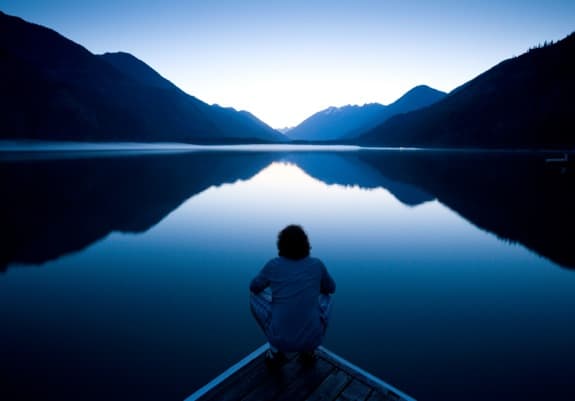
Practicing Stillness
A new student arrives at the monastery and says to the Abbot, “I want to join. How long is it going to take me to be enlightened?”
And the Abbot says; “Ten years.”
Student, “Well, what if I work twice as hard?”
“Twenty years.”
“Well, wait a minute! You just said ten years!” the student exclaimed.
For you, 30 years.”
Achieving a connection to the Divine is not like becoming good at the piano or playing a sport. Grasping and pushing bring the ego so much into play that it can drive the desired result of spiritual fulfillment further away. The practice that is necessary is the practice of stillness, letting go, surrendering control.
Consider building a fire… it will not burn unless there is space between the logs. Too much packed too tightly can smother the flames just as surely as a bucket of water. A fire burns and grows because there is space for the air to move through. So it is with the Spirit, we must make room for the Spirit to move through our days and our lives. When we make that space, our lives can then be informed by the Wisdom of the Spirit, and we can live our lives from the inside out.
This is the goal – to live our lives from the inside out, rather than from the outside in. To be reflective rather than reactive.
Jesus clearly lived from the inside out. His wisdom and calm manner were present in almost every interaction we read about in scripture. I'd be willing to be that his practice of stillness played a big part in cultivating this ability. When reading the Gospel of Mark I found many moments Jesus took time to get away, be still, and get centered. He could often be found walking along the lake, or through a field, or hiking up the hillside to pray – sometimes inviting the disciples to join him. He also encouraged his disciples to stop and rest instead of pushing and pushing. Sadly, Jesus' quiet time was consistently interrupted by people who wanted something from him – teaching, healing. But it didn't stop him from trying!
Today we’re going to talk a little more about the practice of stillness and I have a few ideas that you might try out.
A number of years ago there was a story on NPR about a trauma team at the University of Virginia emergency room who described having witnessed so many deaths that they had become almost numb to the experience.
One day, after one of the patients died, the chaplain walked in the room and asked the medical team to stay for a moment while she said a prayer. The next time there was a death, Johnathon, one of the nurses who had been inspired by the act of stopping, took initiative and invited the team to stay, saying, “Can we stop just for a moment, to recognize this person in the bed? You know, this person before they came in here was alive — they were interacting with family, they were loved by others, they had a life." They all circled around and paused for a minute of silence to honor the person with their thoughts or prayers.
Afterwards, each member of the team reported feeling really touched, as if that time had allowed them to sense the wholeness of that Being – they were not just an object to be checked off the list, but a Being. Those few moments of pausing lent a sense of sacredness to the process.
What has now become known as The Pause spread to other emergency workers, other doctors and EMTs who picked up the practice, saying it helped them acknowledge the loss without disconnecting emotionally or becoming overwhelmed. Eventually, The Pause started being taught as part of the curriculum in the university’s nursing school.
Practicing The Pause, or intentional stillness helps in bringing lasting inner peace to our lives. As Eckhart Tolle says, just witnessing our own mental reactions as they happen is the beginning of the awareness of how our thoughts can rule our lives.
Tolle also says that "a good spiritual practice for us is not to take our thoughts too seriously."
I had two kids who played high school golf. It’s like the bad shot in golf… you must move past the bad shot or it will negatively affect the rest of your game. You must be able to take a step back, see that it is only one shot, notice your attachment to the negativity to this and let it go. This, in my humble non-golfer opinion, is THE hardest thing to do in golf.
It can also be THE hardest thing to do in life. We need to learn to cultivate a neutral mindset, to stop assigning emotions to something someone said or did, or something that happened (like a bad shot in golf). We need to let things go and not get sucked into the drama. We’re called to take a step back, pause, watch and wait and let things move by without getting attached to them.
I WANT to live from the inside out, though I'm not always successful. Still, I find myself practicing a neutral mindset more and more. If I get frustrated or whiny, or down, I try to pause and look at myself, my reactions and my emotions to understand where they are coming from without judging them. Often it is simply from a need to control, or from not having my expectations met. Then I can take a deep breath and intentionally let go of that need to control. Or if it is sadness, I can be compassionate with myself, give myself some tender loving care, and then I’m able to move forward again.
Sometimes this can be really hard to do. When my kids were little, there were times I knew I wasn’t in a good place to deal with them. I was aware enough to know that I was just going to make the problems worse if I didn’t take a step back. So, I’d give myself a time out. “Mom needs a time out!” And I’d go to my room and take some deep breaths and get out of that bad place before going back out.
Consistent meditation is probably the best way to build the pause muscle. However, I’m aware that most of us don't have the temperment, the time or the desire to start and maintain a meditation practice. For those of you who do, you are awesome and I humbly bow to you.
For the rest of us, it is completely possible to practice informal pausing throughout the day. Just 20 second pauses can help to interrupt the auto-pilot mode we find ourselves in. A 20 second pause is just 2-3 deep breaths. Giving yourself set triggers of when you are going to pause can help to maintain the practice. For example, pausing when you sit down with your coffee in the morning, pausing as soon as you sit down at your desk, pausing when you arrive somewhere in your car. Or for those of us who are list people, we can put stillness on our to-do lists!
Another thing that helps me when I take that pause is to recall a time when I experienced that deep inner peace and reach for it once again. I know it is possible, so it helps me to get back there. Or I use a mantra if I sit for a few minutes, continuously pulling myself back from my thoughts to a word or phrase.
Hopefully if we practice occasionally and we feel the resultant calmness and centeredness, it will help us cultivate the awareness to use it when we need it. When we feel pressured to respond before we are ready, we’ll remember to take a deep breath. When we feel anxious and tense inside, we’ll pause for a deep breath. When we are overwhelmed with things people want of us (like Jesus was), we’ll step away for a few minutes.
Let me leave you with one last thought. Sri Daya Mata, a great American Hindu leader once said, "After one milks a cow, filling the pail to the brim, if he then carries it carelessly, spilling all the contents on the way to the house, there was no point in collecting the milk, because it has all been wasted. The same is true about meditation. After achieving stillness within, it is important to very carefully, watchfully carry that pail of peace with us throughout the entire day, drinking deeply from it."
Love & Light!
Kaye



